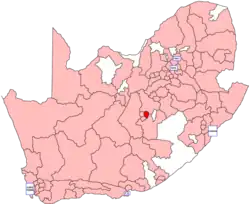Bloemfontein North (House of Assembly of South Africa constituency)
| Bloemfontein North | |
|---|---|
| Former constituency for the South African House of Assembly | |
 Location of Bloemfontein North within South Africa (1981) | |
| Province | Orange Free State |
| Electorate | 16,764 (1989) |
| Former constituency | |
| Created | 1920 1974 |
| Abolished | 1938 1994 |
| Number of members | 1 |
| Last MHA | Frik van Heerden (NP) |
| Created from | Bloemfontein District (1974) |
| Replaced by | Free State (1994) |
Bloemfontein North (Afrikaans: Bloemfontein-Noord) was a constituency in the Orange Free State Province of South Africa, which existed from 1920 to 1938 and from 1974 to 1994. It covered the northern parts of Bloemfontein, the provincial capital and the judicial capital of South Africa. Throughout its existence it elected one member to the House of Assembly.
Franchise notes
When the Union of South Africa was formed in 1910, the electoral qualifications in use in each pre-existing colony were kept in place. In the Orange River Colony, and its predecessor the Orange Free State, the vote was restricted to white men, and as such, elections in the Orange Free State Province were held on a whites-only franchise from the beginning. The franchise was also restricted by property and education qualifications until the 1933 general election, following the passage of the Women's Enfranchisement Act, 1930 and the Franchise Laws Amendment Act, 1931. From then on, the franchise was given to all white citizens aged 21 or over. Non-whites remained disenfranchised until the end of apartheid and the introduction of universal suffrage in 1994.[1]
History
While slightly more liberal than the rest of the Free State, Bloemfontein was still the most conservative of South Africa's major cities. It was first split into North and South constituencies in 1920, after a decade as a single seat, and after a brief period with a National Party MP, Bloemfontein North became the only Free State constituency ever to be represented by a Labour Party member. Arthur Barlow held Bloemfontein North until 1929, and in the Labour Party split of that year, he joined Walter Madeley's faction which advocated against continuing in government alongside the NP. The pro-government Creswell faction nominated Fred Shaw as a replacement candidate, and he was duly elected with Nationalist support. 1933 saw a rematch of sorts, with Shaw standing for re-election and Barlow being nominated as a candidate for Tielman Roos' new party - although he did better than most "Roosite" candidates, it wasn't enough to defeat Shaw in a straight contest. When Bloemfontein was rearranged into City and District seats for the 1938 election, Shaw stood as an independent for the City seat and lost badly.
Bloemfontein North was recreated in 1974, when the District seat was abolished and Bloemfontein was rearranged into three compass-point seats. The new seat, like the rest of the city, was safe for the governing National Party. Its last MP, Frik van Heerden, went on to serve a term in the non-racial National Assembly, retiring from politics in 1999.
Members
| Election | Member | Party | |
|---|---|---|---|
| 1920 | J. W. G. Steyn | National | |
| 1921 | Arthur Barlow | Labour | |
| 1924 | |||
| 1929 | Fred Shaw | ||
| 1933 | |||
| 1938 | constituency abolished | ||
| Election | Member | Party | |
|---|---|---|---|
| 1974 | G. P. de la R. Terblanche | National | |
| 1977 | |||
| 1981 | |||
| 1987 | Frik van Heerden | ||
| 1989 | |||
| 1994 | constituency abolished | ||
Detailed results
Elections in the 1920s
| Party | Candidate | Votes | % | ±% | |
|---|---|---|---|---|---|
| National | J. W. G. Steyn | 894 | 43.1 | New | |
| Labour | Arthur Barlow | 598 | 28.8 | New | |
| Unionist | H. F. Blaine | 584 | 28.1 | New | |
| Majority | 296 | 14.3 | N/A | ||
| Turnout | 2,076 | 66.5 | N/A | ||
| National win (new seat) | |||||
| Party | Candidate | Votes | % | ±% | |
|---|---|---|---|---|---|
| Labour | Arthur Barlow | 1,246 | 57.3 | +28.5 | |
| National | J. W. G. Steyn | 930 | 42.7 | −0.4 | |
| Majority | 316 | 14.6 | N/A | ||
| Turnout | 2,176 | 66.4 | −0.1 | ||
| Labour gain from National | Swing | +14.1 | |||
References
- ^ "EISA South Africa: Historical franchise arrangements". Eisa.org.za. Archived from the original on 9 May 2013. Retrieved 6 July 2012.
- ^ Schoeman, B.M. (1977). Parlementêre verkiesings in Suid-Afrika 1910-1976. Pretoria: Aktuele Publikasies.
- ^ Standard Encyclopaedia of Southern Africa (1972). "House of Assembly" (vol. 5, pp. 617–636). Cape Town: Nasionale Opvoedkundige Uitgewery (Nasou).
- ^ South Africa 1980/81: Official Yearbook of the Republic of South Africa. Johannesburg: Chris van Rensburg Publications.
- ^ South Africa 1983: Official Yearbook of the Republic of South Africa. Johannesburg: Chris van Rensburg Publications.
- ^ Government Gazette of South Africa, No. 10751. 22 May 1987. Pretoria: Government of South Africa.
- ^ Government Gazette of South Africa, No. 12109. 20 September 1989. Pretoria: Government of South Africa.